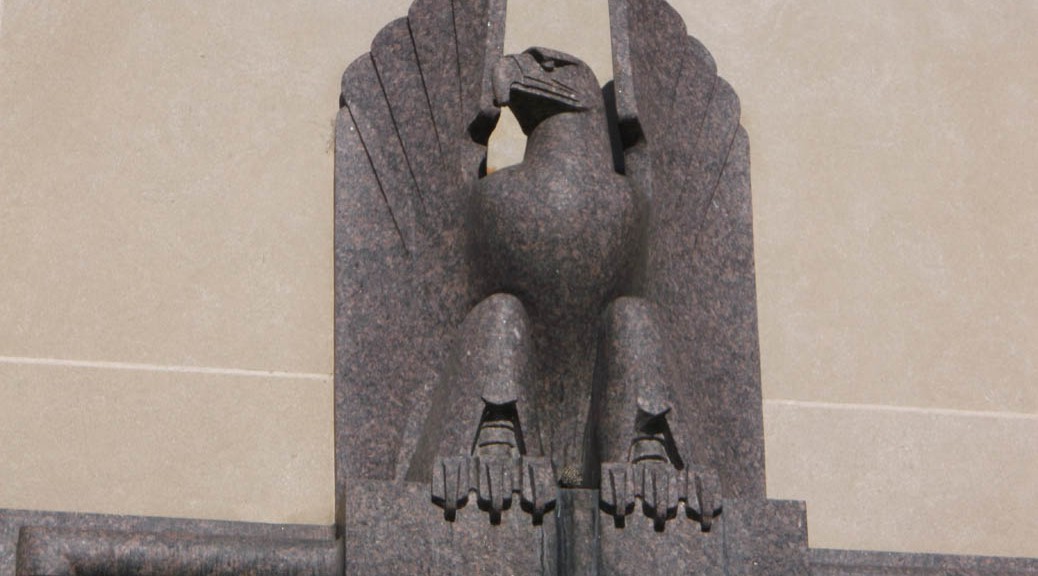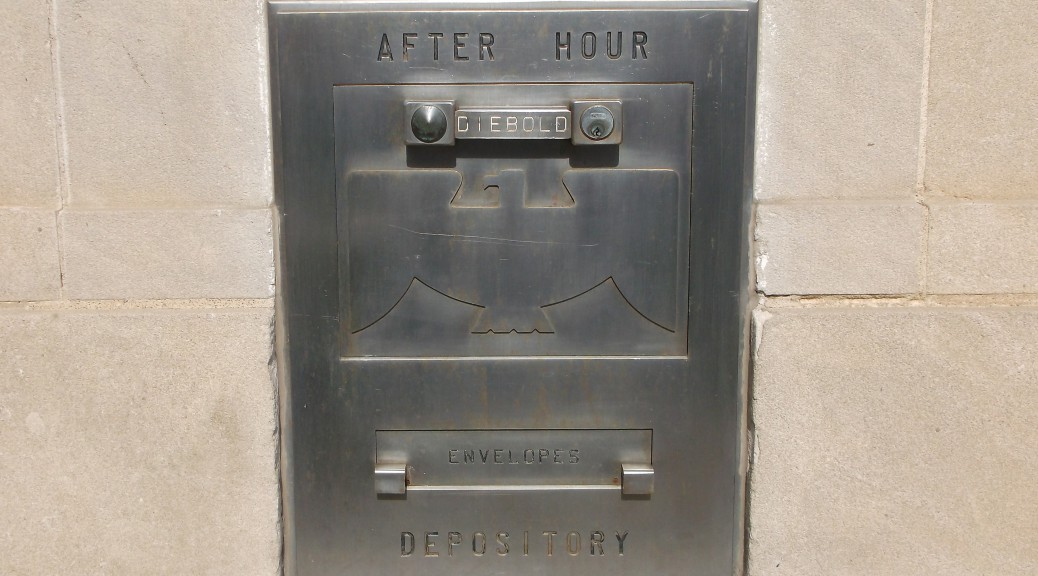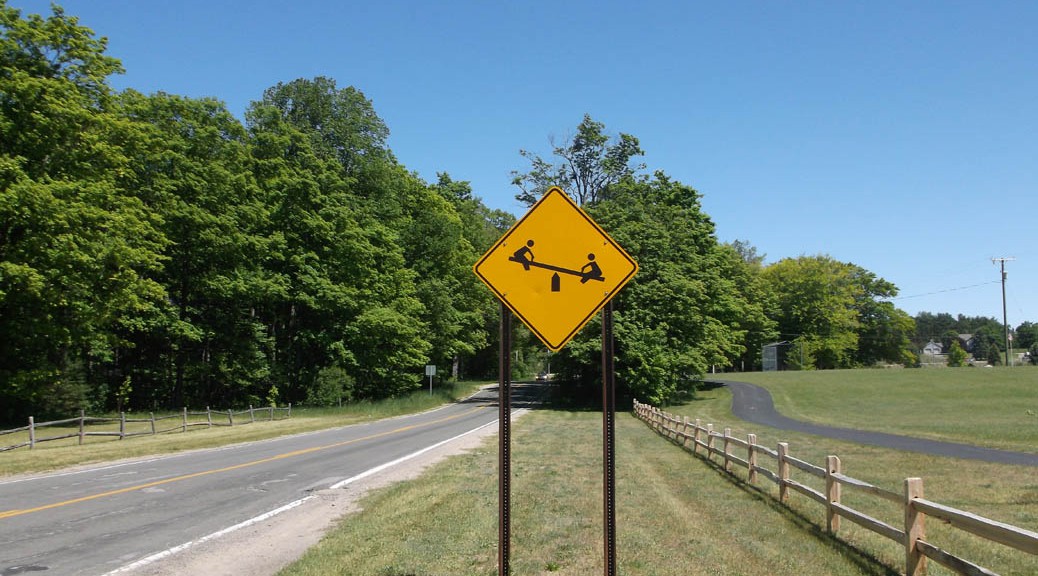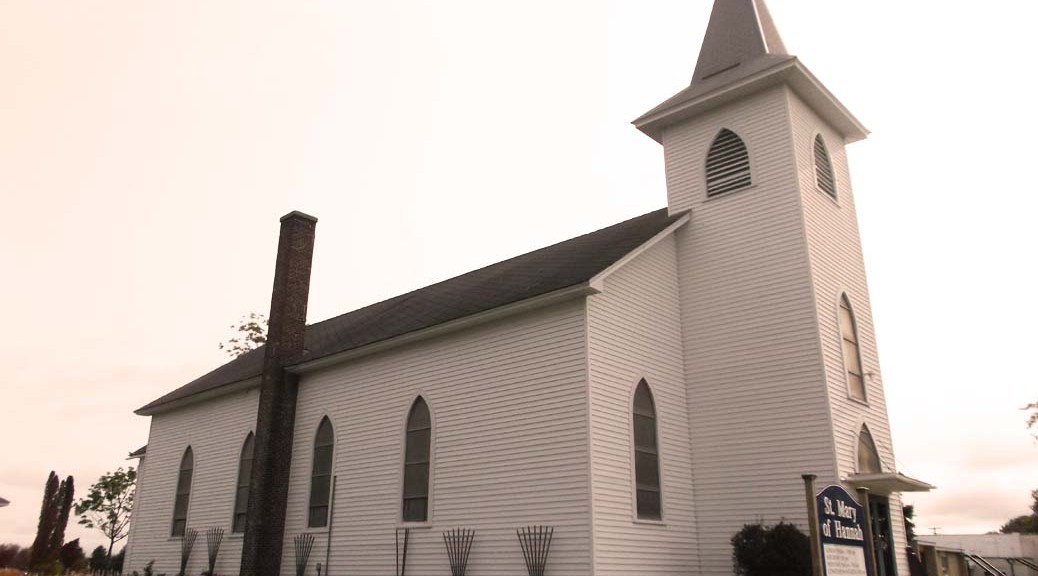Recognize this imposing figure? I am sure you have seen him looking down at you from his perch on a building! Hint: Know of any surviving Art Deco buildings in Traverse City?
Monthly Archives: August 2014
Growing Your Own House: The Mites of Maple Bladder Galls
In early summer you may have noticed small pouches on red and silver maple leaves. If you open one up, you will find—nothing at all. Or so it seems. In fact, the creatures that live there are swarming all around.
They are microscopic mites of the eriophyid family, so small you would need a 400X magnification to study them in detail. Unlike most mites, they have but four legs—not eight—with two pairs clustered around the animal’s mouth. Dwelling within such a small space, eriophyids hardly have need of legs at all: for most of their lives their universe is no bigger than the gall they inhabit.
The life cycle of the mite is simple. They mate and reproduce within the secure enclosure of the gall, producing several generations within a summer. Before leaves change color in autumn, obeying a signal we do not know, they migrate out of their chamber to the bud scales of next year’s leaves or to protected areas under loose bark. Dormant, they wait there for the cold blast of winter.
In spring, before leaves expand, they enter young leaves on the underside, their presence initiating the balloon-growth of many pouches, the number ranging from a half dozen or so to an ugly multitude that deforms the leaf. While the mites undoubtedly sap energy from trees, they cause little permanent damage. Gardeners and foresters generally ignore their presence, not wasting effort or chemicals to discourage them.

I think leaves adorned with crimson maple bladder galls are attractive, resembling miniature Christmas decorations in the month farthest removed from that holiday. They can be pointed or inflated depending upon the species of mite involved and colors vary, frequently starting off green and becoming red before fading to a dull brown. Can they be thought of as a rash trees get? Not exactly, since they do infect the surface tissues alone, unlike human dermatitis.
Another kind of eriophyid attacks plants in a different way. Instead of making galls, it secretes a chemical that induces plants to grow a forest of slender hairs called an erineum. An erineum—taken from the Greek word for fleece—can be found on the lower surface of leaves of many plants: oaks, maples, viburnum, and grapes are especially affected. It may appear as a velvet fuzz, white or commonly red in color.
As with the gall-forming eriophyids, the erineum mites are exceedingly difficult to see even with a powerful magnifier. A twenty-power lens might reveal their presence, though sharp eyes will be called for. A microscope, of course, would work better.
Somehow I connect these animals with larger herbivores like bison.. I imagine them roaming over the fields of hairs they caused to grow, feeding upon them as the bison would, a prairie in a square inch. Throughout early summer they graze, finally retiring to bud scales and bark for the winter. Occasionally a stiff wind will blow them right out of the erineum, something bison do not have to worry about. Of course, the advantage for the mite is that it might get blown to a new tree, fertile ground to establish a new miniature prairie ecosystem.
Nature performs its work at every scale: planet, ecosystem, organism, organs, tissues, and cells. Isaac Asimov, the famous science fiction writer, once wrote about exploring the world extending from his backdoor. After much study he had gotten as far as a few feet from his porch, so numerous were the species he encountered. Most likely he did not get around to the mite-formed galls or erineums on his shade trees.
Richard Fidler is a retired teacher of biology, a Traverse City historian and an editor of the Grand Traverse Journal.
Where is it? What is it? When was it?
Can you guess what this is and where it is located? You can see it from the street in downtown Traverse City, but you need to be looking down!
Did you figure it out? It’s the after-hours deposit box of the old Northwestern Savings Bank on Cass and Front Street, facing Cass. Although the building is no longer a bank, we appreciate that this relic was left intact! Thanks to reader Julie of Traverse City for providing the answer!
Windows to Our Past: Traffic Warning Signs Along Small Roadways
I am a member of a tiny group of history buffs entitled—we think amusingly—the Backspacers. We occupy seats in a local coffee place for hours at a time, fueling our discussion of old buildings, old people, and old ways of doing things with plenty of pie and coffee. While we have enjoyed long residencies in the Traverse area, none of us was born here. For this we suffer the unspoken scorn of those few families that boast two or three generations in Northern Michigan. That, however, does not raise our hackles in the least: we accept our short-termer status with grace.
One of the traits of us Backspacers is a pronounced tendency to linger over everyday things that express a connection to the past. Long have we marveled at manhole covers with the writing “Citizens Telephone Company,” at the blockhouse just under the Union Street dam that was said to hold money for workers in the Flour Mill located there, at the faded printing on a landmark building declaring it to be the “Traverse City Gas Company,” at Civil Defense bomb shelter signs, at the evidence of fire that nearly consumed the Wilson Antiques building. One of us—me, actually—spent time looking for cinders along Railroad Street, a curving road that paralleled tracks that accommodated coal-burning steam locomotives.
For Backspacers automobile travel can be hazardous. Rapid stops occur as one or the other of us abruptly notices something out of time: an artesian well, an old home designed by a local architect more than a hundred years ago, the site of an old sawmill, or highway signs that suggest something misplaced in time. In particular, those signs, yellow with black icons, fill me with joy.
 Take note of the warning sign advertising the presence of a fire station, found on Veterans Drive and elsewhere, no doubt. Is it not comical—the silhouette of a 1930’s fire engine complete with helmeted driver? How well it communicates “fire truck” with the ladder clearly hanging from the side of the truck. No modern fire truck could substitute since most of them could be confused with any delivery truck in profile. Still, you wonder how long we will keep an icon that resembles artwork from a children’s storybook. A long time, this Backspacer hopes.
Take note of the warning sign advertising the presence of a fire station, found on Veterans Drive and elsewhere, no doubt. Is it not comical—the silhouette of a 1930’s fire engine complete with helmeted driver? How well it communicates “fire truck” with the ladder clearly hanging from the side of the truck. No modern fire truck could substitute since most of them could be confused with any delivery truck in profile. Still, you wonder how long we will keep an icon that resembles artwork from a children’s storybook. A long time, this Backspacer hopes.
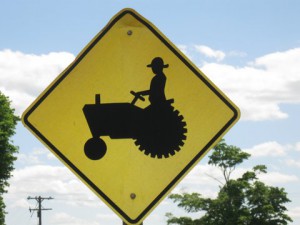 The sign for “Farm Equipment” portrays a stereotypical view of the farmer. An individual with a wide-brimmed hat sits on a primitive tractor, the stalk of grass clamped in his jaws apparently too small to be stenciled. A modern fancy tractor with its enclosed air-conditioned cab is not pictured—since it lacks the clear connections among man, machine, and farming. “Cattle Crossing” signs—the animals artfully represented–similarly urge caution in rural communities.
The sign for “Farm Equipment” portrays a stereotypical view of the farmer. An individual with a wide-brimmed hat sits on a primitive tractor, the stalk of grass clamped in his jaws apparently too small to be stenciled. A modern fancy tractor with its enclosed air-conditioned cab is not pictured—since it lacks the clear connections among man, machine, and farming. “Cattle Crossing” signs—the animals artfully represented–similarly urge caution in rural communities.
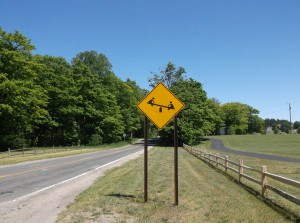 The sign for “Playground” is equally charming: it shows two children on a teeter totter. Oddly, teeter totters have been banned from modern playgrounds upon the discovery that they have injured large numbers of children. Still, the image keeps the thing alive—at least for us adults—though young children have no idea what a real teeter totter looks like. Another sign indicating children at play shows a boy (presumably) in shorts running carefree, possibly across the roadway. He wears a curious conical hat, something I have never seen on a boy’s head. Does it indicate archaic style or a figure from a foreign land?
The sign for “Playground” is equally charming: it shows two children on a teeter totter. Oddly, teeter totters have been banned from modern playgrounds upon the discovery that they have injured large numbers of children. Still, the image keeps the thing alive—at least for us adults—though young children have no idea what a real teeter totter looks like. Another sign indicating children at play shows a boy (presumably) in shorts running carefree, possibly across the roadway. He wears a curious conical hat, something I have never seen on a boy’s head. Does it indicate archaic style or a figure from a foreign land?
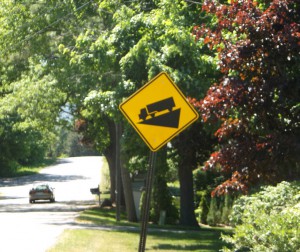 The image of a truck heading down a steep incline denotes a steep hill ahead, but the six-wheeler pictured and the admonition “Use Second Gear” seems out of place and time since it implies a manual transmission with three forward gears. You can find such a sign on Leelanau County Road 616. Of course, all of us old timers remember the installation of the “Runaway Truck Ramp” on M72 leading down to the Bay. Some of us recall the small truck that wound up in the Bay before that salvation was constructed—was it in the seventies?
The image of a truck heading down a steep incline denotes a steep hill ahead, but the six-wheeler pictured and the admonition “Use Second Gear” seems out of place and time since it implies a manual transmission with three forward gears. You can find such a sign on Leelanau County Road 616. Of course, all of us old timers remember the installation of the “Runaway Truck Ramp” on M72 leading down to the Bay. Some of us recall the small truck that wound up in the Bay before that salvation was constructed—was it in the seventies?
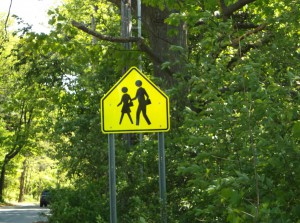 Pedestrian crossing images tell us something about our society. The crossing sign near a school shows a larger figure, wearing pants, with his hand on a smaller figure wearing a skirt. Hazarding a guess about the gender of the figures—and nowadays this is only a guess not a firm conclusion—a man or boy seems to be walking with his hand upon the girl’s arm. To me this suggests he is protecting her as she braves traffic in the crosswalk. Could we have the larger figure wearing the skirt with her hand on the boy? After all, it is just as likely an older sister is guiding her rambunctious younger brother across the street. But, no—it is the way it is. Boys protect girls, not the other way around.
Pedestrian crossing images tell us something about our society. The crossing sign near a school shows a larger figure, wearing pants, with his hand on a smaller figure wearing a skirt. Hazarding a guess about the gender of the figures—and nowadays this is only a guess not a firm conclusion—a man or boy seems to be walking with his hand upon the girl’s arm. To me this suggests he is protecting her as she braves traffic in the crosswalk. Could we have the larger figure wearing the skirt with her hand on the boy? After all, it is just as likely an older sister is guiding her rambunctious younger brother across the street. But, no—it is the way it is. Boys protect girls, not the other way around.
 Then there are the wonderful depictions of animals. In particular, the antlered icon rearing on its hind legs says “Deer” so boldly no one could miss it. Often sharpshooters are unable to miss them, too, as they pepper them with indentations with their deer rifles, perhaps in frustration at never hitting the real thing. Bear crossing signs appear nearby, too, near Cadillac along highway M115, for one. The mother bear and her cub are shown, providing gender equality to the buck shown on the deer sign.
Then there are the wonderful depictions of animals. In particular, the antlered icon rearing on its hind legs says “Deer” so boldly no one could miss it. Often sharpshooters are unable to miss them, too, as they pepper them with indentations with their deer rifles, perhaps in frustration at never hitting the real thing. Bear crossing signs appear nearby, too, near Cadillac along highway M115, for one. The mother bear and her cub are shown, providing gender equality to the buck shown on the deer sign.
Backspacers are not content to note the existence of relics. They must do research to find out more. Are the signs of Michigan recognized in other states? In other countries? Exactly when were they created and who does the creating? The web provides us with a few answers: The United States Department of Transportation Federal Highway Administration sets the standards for traffic signs. It publishes the official manual for signing, the Manual on Uniform Traffic Control Devices (MUTCD). The manual has been constantly updated from its beginnings in 1935, the latest issued in 2009.
The 1971 edition expanded the kinds and numbers of signs considerably. An effort was made to bring signs from various nations into conformity, telling us that the rearing deer beloved of Backspacers and most Americans can be seen in countries that deer inhabit. The figure for Japan, though, faces the opposite direction from its American counterpart since Japanese drive on the left side of the road. Perhaps the antiquated fire truck pictured on our signs represents those still in operation in less wealthy lands.
The history of standard sign usage goes back to the beginning of automobile travel. In the first and second decades of the twentieth century there were no standard signs across the United States. Signs could be any shape, any color, any size—with varying print fonts, messages, and iconic pictures. In 1927 the Joint Board (a precursor to the MUTCD) published the specifications for the signage we use today. Warning signs were to be yellow with black print in the shape of a diamond. The standard shapes and colors for railroad crossings (round), stop signs (octagonal), and informational signs (rectangular) were spelled out in the report. All at once highway signage had become clear, modern, and universal.
Yellow warning signs have proliferated over the last seventy years, indicating greater sensibility of automobile drivers to their driving environment. How else to explain “Deaf Child Area”, Moose Crossing, or even an image of a mother duck with her ducklings trailing after—presumably a “Duck Crossing” warning? We Backspacers hope these images will never disappear even as we proceed into an age without teeter totters and fire trucks without ladders. Without pretension, they provide windows to our not-so-distant past.
Sessions, Gordon M., Traffic Devices: Historical Aspects Thereof, Washington, D.C.: The Institute of Traffic Engineers, 2029 K. Street N. W., Washington, D.C. 20006, 1971
Richard Fidler is a retired teacher of biology, a Traverse City historian and an editor of the Grand Traverse Journal.
Hannah St. Mary’s: the Treasure
Hannah St. Mary’s has a story no one besides a few select people know. This is that story.
It all started when the first settlers came to Hannah. Around 1850 Perry Hannah, A.T. Lay, and James Morgan came and bought a sawmill along the Boardman River and started a business. Then in 1857 Congress passed a grant allowing funds to build a railroad in Michigan from Grand Rapids to Traverse Bay. In 1862, George Nickerson and his family came and urged other families to join them. In 1872, with the railroad finally finished, settlers came from all over for the cheap land and the plentiful amount of timber.
Later, after the railroad was built, they decided that they needed a church, building and completing it in 1885. However, the church did not have any altar fixtures in it until around 1896 when they bought their altar. It cost $81.84. It probably does not seem like much to us, but back then it was a large sum of money.
As always, horrible things seem to constantly plague good people; this church was no exception. In the late 1800s or early 1900s robbers on horseback stole everything from their altar. That, ladies and gentlemen, is where this story begins…
This is the account told to me by Eugene and Jim Johnson. In 1982 on Easter Sunday Eugene Johnson took his eight-year-old son Jim fishing on Fish Lake. It was a slightly chilly, foggy day but you could still fish. They also took Jims’ metal detector to fiddle around with later.
At long last, after continually failing to tempt the fish to bite, they pulled out the metal detector. They started in the parking lot, just finding small things such as pennies and other small coins. But as time passed, they wandered on down into the more swampy area of the woods past the campground, and over a bank when suddenly the metal detector was almost off the scale.
When they looked down they saw something that resembled metal. They set the detector down and gently started digging. Soon they discovered that the first piece of metal was the base of a tarnished candlestick. They kept digging as the fog danced around them. Soon Jim found a potato sack; When it finally left its grave, it was revealed that it was chock-full of more candlesticks and vessels. As they dug even deeper, they started uncovering more candelabras–and discovered the piece that explained what all the others were, a large cross.

Eugene, once having been an altar boy, recognized the cross as one that might grace an altar. The question was where had these treasures come from? Eugene had never heard of a robbery of a church in the area. But they couldn’t just leave these gorgeous treasures alone could they?
They packed the pieces off and went home to ponder their questions in a safer setting. When they arrived home and explained the situation to Eugene’s wife, Vicky, she suggested, “Why don’t you take it to our pastor, Father Murphy?”
They did just that. After explaining their predicament once again, Father Murphy agreed that the artifacts were in fact like the ones put on a Catholic Church altar. However, while the tarnished silver artifacts were found, none of the gold artifacts that would grace an altar were found.
Father Murphy suggested that he take the items in question and in the meantime he would look through old church files and see if he could find out the story behind the artifacts.
Later that day or the next, Father Murphy called up Eugene and said, “Have I got a story for you.” He then proceeded to tell them that in the late 1800s or early 1900s the Hannah St. Mary’s Church had been robbed on horseback. The number of bandits and who they were are an unsolved mystery to this day.
Pretty amazing story huh? Sadly the story never reached the news. The artifacts were put on display in the church rectory; Diane Gray, a Church secretary, remembers seeing some tarnished altar pieces in the office. However, today they are probably stuck in some dusty boxes, shoved into an even dustier basement where their history will never see the light.
I am sorry to say that though many questions have been asked, no one can remember this story and that has made it hard to gather facts, though I am ecstatic that, due to research questions, more people know this fascinating story. I have spent several hours at the Traverse Area District Library looking at newspapers but have not found any mention of the robbery of any churches except for an attempted robbery of the St. Francis church in 1905. I did discover that the early history of the town was filled with robberies and murders. I spent quite a bit of time talking to members of the church whose families belonged to the church for a long time such as Margret Lewis, Messrs. Ray and Jay Weber and former parish secretaries such as Diane Gray and Terry Javin. I also spoke with Sue Zenner the daughter of Julia Harrand who wrote a book on the history of Hannah St. Mary, and interviewed Eugene and Jim Johnson who were the ones who found the treasure.
Hannah Carr is a student at Kingsley Area Schools, who is passionate about writing and research, although she prefers writing mysteries to nonfiction. Carr was one of the winners of the 2014 Floyd Milton Webster Prize for History (Kingsley), Young Adults, for this article. She plans to be responsible with her Prize winnings, and the Editors look forward to her entry next year.
Earliest Settlers of Almira Township
Contributor Richard Leary and his wife, Eleanor Riehl Leary, are summer residents of Lake Ann.
Addison and Ann Wheelock, my wife’s great-great grandparents, were the first European settlers in the Lake Ann area. The lake, Ann Lake, was named for Ann Wheelock. While Eleanor was doing family history research, I began researching the history of the village of Lake Ann.
The village has a long and fascinating history, extending from its logging days in the 1860s into the early 20th century. At the turn of the century – 19th to 20th – Lake Ann was a tourist destination, with daily trains bringing people from Traverse City and Manistee. An elegant hotel, the Douglas, stood just a short walk from the fine train depot and another hotel, the Lake Hotel, was just down the road.
Lake Ann boasted (if that is the correct term) of a half-dozen or more saloons, good card games and, according to rumors, several brothels.
Among Lake Ann’s more noted historical events were three major fires, each of which nearly destroyed the town. Lake Ann survived and today is a busy, growing community.
But I get ahead of myself.
During the spring and summer of 1862, three groups of settlers arrived in the area that later became Almira Township. They homesteaded different places and later obtained land grants for their land.
Addison (28) and Ann (28) Wheelock, with their first two children, Ebenezer (6) and Mary (3) settled on the north shore of Ann Lake. Addison named the lake for his wife. The Wheelocks came from Vermont.
Andrew (32) and Almira (30) Burrell arrived about the same time. They settled on the north side of Sancrainte Creek. An area northwest of Ann Lake was informally known as “Sancrainte Hill.” This is consistent with Andrew Burrell’s land grant. The township was later named for Almira Burrell. They apparently only farmed that area briefly as they were listed in the 1880 census in Monroe County in southern Michigan. The Burrells came New York.
Also arriving during 1862 were two brothers from Canada. Alexander (Alex or Alec) and John (30) Heather settled on the northeast end of what is now called Stevens Lake. Alexander Heather obtained a land grant for a quarter section of land in section 3 and a quarter-quarter section in section 14, northeast of Ann Lake. They farmed the land on the shore of Stevens Lake for several years before selling. Only John was listed on the 1870 census. We were unable to find either John or Alexander Heather listed anywhere in the 1880 U.S. census. They may have returned to Canada.
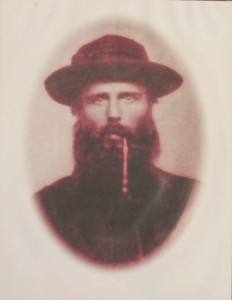
Addison P. Wheelock and his wife Ann were among the first settlers in Benzie County, Michigan, and the first in the Lake Ann area. Soon after they arrived from Vermont in 1862, Addison acquired extensive land on the north shore of Ann Lake. Eventually he owned all the land now occupied by the village of Lake Ann.
It is unknown exactly where the Wheelocks lived. Their home was probably on or very near the new Almira Township Park. As reported in the Grand Traverse Herald on 28 June 1883, Ann Wheelock hosted a Fourth of July party on her property:
There will be a Fourth of July celebration held in the woods on Mrs. Wheelock’s farm, near Lake Ann. L. Palmer will have his swing on the grounds. J. J. Gray and R. Gane will have a stand where refreshments will be sold and there will be boats furnished for those who like excursions on the water. The pleasures of the day will end with an oyster supper in the evening at Mr. Hathaways.
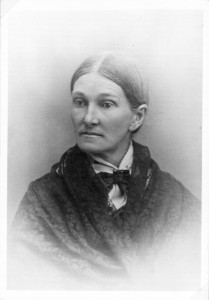
Addison Wheelock was among the founders of Almira Township and the village which later became Lake Ann. The lake was named for his wife, Ann McBride Wheelock. He was active in local politics, was the first sheriff of Benzie County and served on many local committees.
Addison acquired much land, most of it land grants from the U.S. government through the General Land Office (GLO). A few pieces of land were purchased from the Auditor General of Michigan in tax sales. By 1872, Addison Wheelock owned nearly 450 acres in Benzie County. On the 1870 census he valued his property at $10,000, far more than anyone else in the area.
After arriving in what is now Lake Ann, Addison and Ann had 5 more children:
1. Ebenezer T. – b. Apr. 20, 1856, Vermont,
2. Mary Ann – b. Sept. 24, 1858, Vermont,
3. Willie A. – b. Feb. 14, 1863, Michigan,
4. Hector C. – b. Apr. 18, 1865, Michigan,
5. John P. – b. Mar. 21, 1868, Michigan,
6. Julia E. – b. Dec. 23, 1869, Michigan,
7. Amy A. – b. Jan. 28, 1876, Michigan,
Sometime during the summer of 1883, Addison P. Wheelock left this area, leaving behind his wife and children. Vague rumors of distant destinations have proven fruitless. In Ann Wheelock’s estate papers, Addison’s address is listed as Bear Lake. This misinformation was probably given by the eldest son, William. The search, now more than a decade old, continues.
The Leary’s are volunteers at the Almira Historical Society Museum, whose holdings provided some information and images for this article. Please visit the Museum at 19440 Maple Street, Lake Ann, for further information on the history of Almira Township.
A Mystery at Every Turn
This month we offer a mystery solved: Hannah St. Mary’s: A Treasure. Written by thirteen year-old Hannah Carr, one of the winners of the Floyd Webster Teen Prize, 2014, it exemplifies the kind of work we welcome here at the Journal, an authentic telling of a historical event long forgotten. The piece also exemplifies the authors we want to hear from: writers with curiosity and a passion for research.
Have you ever wondered about those yellow signs informing drivers that a fire station is nearby—or a playground, or a deer crossing? Who designed and approved them? Just when did they appear along highways? Why do they reflect such antiquated pictures of fire trucks and tractors? You will find answers to your questions in Windows to Our Past: Warning Signs Along Small Roadways, an article in our “Then and Now” section.
Speaking of other things we take for granted, what are those pimple-like things you see on maple leaves this time of year? You may be surprised to learn they house creatures far smaller than the head of a pin. Check them out in Growing Your Own House: The Mites of Maple Bladder Galls in Nature.
Traverse City is a town of festivals: the Cherry Festival, the Film Festival, the Comedy Festival, and more to come, no doubt. In August, 1911, Traverse City celebrated—itself!—in a grand festival. “Farmers came with their families, and city folk, too. The rich and poor mingled. Young and old. Factory workers and their bosses.” All came out for a picnic at the present Civic Center. There, among all other entertainments, a speech greatly relevant to our modern world was given. Read about it in Traverse City Day.
One of those picnickers might have come from Almira Township, Benzie County. Read about the founding mothers and fathers of that place in Richard Leary’s Earliest Settlers of Almira Township under “Celebrating the People”. We hope others will tell us about their explorations of local history.
Finally, the Mystery Photo, the answer to last month’s and the challenge of this month. A reader correctly identified the location of last month’s after hours deposit box, as you will discover if you peek in that section. Now a granite eagle confronts readers. Where is it?
Traverse City Day, 1911
August 30, 1911, the Record-Eagle’s headlines told the story:
“GREAT CROWD AT PICNIC
TRAVERSE CITY DAY WAS HUGE SUCCESS
THOUSANDS HAD GOOD TIME
MEN, WOMEN AND CHILDREN ENJOYED RECREATION
Stores and Factories Closed Most of Day—Greatest Gathering Ever on Grounds Saw Thrilling Ball Game”
Before the Traverse City Film Festival, before the Cherry Festival, Traverse City held a celebration of its own, a festival that carried no overtones of patriotism or commercialism. Participants were invited to bring their own picnic goodies to the Civic Center (then called the Driving Park) for a day of fun. Farmers came with their families, and city folk, too. The rich and poor mingled. Young and old. Factory workers and their bosses. Estimates of the crowd varied between 8,000 and 10,000 people.
They ate and they partied. There were day fireworks and paper balloons launched for children, a bowery dance (a dance held outside) for the young, and the culminating baseball game for all who cared for that sport. In 1911—but not in 1912, the final year of Traverse City Day—speeches were offered to the crowd. One of them stands out because of its relevance to today’s social climate. Here are the words of the Record-Eagle in describing it.
Judge A. L. Deuel, member of the executive board of the Western Michigan Development Bureau, was the next speaker. Introduced by Mr. Amiotte. He had many good things to say and he said them in a manner that impressed his hearers with the fact that he knew what he was talking about. Mr. Deuel is full of vim and fire and his address had a tendency in showing the farmers and the city people as well what it means not to patronize home industries. “Traverse City is a live city, a beautiful city,” he said, “and she is becoming more beautiful every year. If we could go through a Rip Van Winkle sleep of twenty years and awake to find the great Grand Traverse region, we would be astounded at the great growth. All this is taking place just the same only we are not asleep and the development is taking place so fast that we don’t realize it. If any of you farmers or city people either, are sending to Sears & Roebuck or any other mail order house for goods, cut it out. The home trade is what we need to help pay our taxes, and Sears Roebuck will never help you. They wouldn’t know you if you went into their store. They don’t care, all they want is your money. We are now living in the best age of the world. What are you doing for your community? Work together for your county, your township, and do your best always. No man can do more than his best, and when you have done that the duty of man to his country is fulfilled.
This concluded the program and everybody flocked to the diamond to see the great battle of baseball, the feature attraction of the day.

